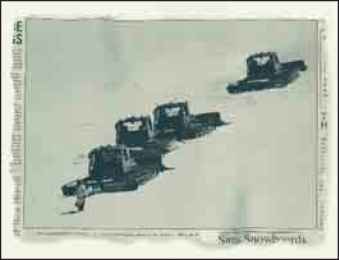Creative Tactics for Print Advertising
The basic components of a print ad are the headline, the body copy, the visual or illustrations, and the layout (the way they all fit together). The headline and body copy portions of the ad are the responsibility of the copywriters; artists, often working under the direction of an art director, are responsible for the visual presentation. Art directors also work with the copywriters to develop a layout, or arrangement of the various components of the ad: headlines, subheads, body copy, illustrations, captions, logos, and the like. We briefly examine the three components of a print ad and how they are coordinated.
Headlines
The headline is the words in the leading position of the ad—the words that will be read first or are positioned to draw the most attention. Headlines are usually set in larger type and are often set apart from the body copy or text portion of the ad to give them prominence. Most advertising people consider the headline the most important part of a print ad.
The most important function of a headline is attracting readers' attention and interesting them in the rest of the message. While the visual portion of an ad is obviously important, the headline often shoulders most of the responsibility of attracting readers' attention. Research has shown the headline is generally the first thing people look at in a print ad, followed by the illustration. Only 20 percent of readers go beyond the headline and read the body copy. So in addition to attracting attention, the headline must give the reader good reason to read the copy portion of the ad, which contains more detailed and persuasive information about the product or service. To do this, the headline must put forth the main theme, appeal, or proposition of the ad in a few words. Some print ads contain little if any body copy, so the headline must work with the illustration to communicate the entire advertising message.
Headlines also perform a segmentation function by engaging the attention and interest of consumers who are most likely to buy a particular product or service. Advertisers begin the segmentation process by choosing to advertise in certain types of publications (e.g., a travel, general-interest, or fashion magazine). An effective headline goes even further in selecting good prospects for the product by addressing their specific needs, wants, or interests. For example, the headline in the ad for RCA's LYRA personal digital player shown catches the attention of consumers who want the latest technology in audio products.
Types of Headlines
There are numerous headline possibilities. The type used depends on several factors, including the creative strategy, the particular advertising situation (e.g., product type, media vehicle(s) being used, timeliness), and its relationship to other components of the ad, such as the illustration or body copy. Headlines can be categorized as direct and indirect. Direct headlines are straightforward and informative in terms of the message they are presenting and the target audience they are directed toward. Common types of direct headlines include those offering a specific benefit, making a promise, or announcing a reason the reader should be interested in the product or service.
The headline of this ad catches the attention of young consumers

Indirect headlines are not straightforward about identifying the product or service or getting to the point. But they are often more effective at attracting readers' attention and interest because they provoke curiosity and lure readers into the body copy to learn an answer or get an explanation. Techniques for writing indirect headlines include using questions, provocations, how-to statements, and challenges.
Indirect headlines rely on their ability to generate curiosity or intrigue so as to motivate readers to become involved with the ad and read the body copy to find out the point of the message. This can be risky if the headline is not provocative enough to get the readers' interest. Advertisers deal with this problem by using a visual appeal that helps attract attention and offers another reason for reading more of the message. For example, the ad for the Lexus GS sports sedan shown uses a question as the headline that invites consumers to read the copy to learn more about the features of the car and decide how to categorize it. The visual portion of the ad supports the positioning theme by showing the GS 430 being driven on a windy road.
Subheads
While many ads have only one headline, it is also common to see print ads containing the main head and one or more secondary heads, or subheads. Subheads are usually smaller than the main headline but larger than the body copy. They may appear above or below the main headline or within the body copy. The Cambridge SoundWorks ad shown uses subheads within the body copy.
Subheads are often used to enhance the readability of the message by breaking up large amounts of body copy and highlighting key sales points. Their content reinforces the headline and advertising slogan or theme.
This ad uses a question-style headline and strong visual image that motivate consumers. This ad uses subheads to make the copy copy easier to read

Body Copy
The main text portion of a print ad is referred to as the body copy (or sometimes just copy). While the body copy is usually the heart of the advertising message, getting the target audience to read it is often difficult. The copywriter faces a dilemma: The body copy must be long enough to communicate the advertiser's message yet short enough to hold readers' interest.
Body copy content often flows from the points made in the headline or various subheads, but the specific content depends on the type of advertising appeal and/or execution style being used. For example, straight-sell copy that presents relevant information, product features and benefits, or competitive advantages is often used with the various types of rational appeals discussed earlier in the chapter. Emotional appeals often use narrative copy that tells a story or provides an interesting account of a problem or situation involving the product.
Advertising body copy can be written to go along with various types of creative appeals and executions—comparisons, price appeals, demonstrations, humor, dramatizations, and the like. Copywriters choose a copy style that is appropriate for the type of appeal being used and effective for executing the creative strategy and communicating the advertiser's message to the target audience.
Visual Elements
The third major component of a print ad is the visual element. The illustration is often a dominant part of a print ad and plays an important role in determining its effectiveness. The visual portion of an ad must attract attention, communicate an idea or image, and work in a synergistic fashion with the headline and body copy to produce an effective message. In some print ads, the visual portion of the ad is essentially the message and thus must convey a strong and meaningful image. For example, the award-winning ad for Sims Snowboards shown uses a powerful visual image. In a scene reminiscent of the protestor blocking military vehicles in Beijing's Tiananmen Square during the 1989 student uprising, a snowboarder stands in the path of snow-grooming machines (which pack the snow, to the distress of snowboarders). The single line of copy, "In a courageous act of solidarity, a lone snow-boarder stands up for freedom," reinforces the message presented by the visual image.
Many decisions have to be made regarding the visual portion of the ad: what identification marks should be included (brand name, company or trade name, trademarks, logos); whether to use photos or hand-drawn or painted illustrations; what colors to use (or even perhaps black and white or just a splash of color); and what the focus of the visual should be.
Layout
While each individual component of a print ad is important, the key factor is how these elements are blended into a finished advertisement. A layout is the physical arrangement of the various parts of the ad, including the headline, subheads, body copy, illustrations, and any identifying marks. The layout shows where each part of the ad will be placed and gives guidelines to the people working on the ad. For example, the layout helps the copywriter determine how much space he or she has to work with and how much copy should be written. The layout can also guide the art director in determining the size and type of photos. In the ad for Sims Snowboards shown, the layout is designed to make the ad look like it was reprinted from a newspaper page. Notice how this theme is carried through in the copy, which reads like a newspaper photo caption and ends with "Story on 2C." Layouts are often done in rough form and presented to the client so that the advertiser can visualize what the ad will look like before giving preliminary approval. The agency should get client approval of the layout before moving on to the more costly stages of print production.
This ad for Sims Snowboards uses a strong visual image and a layout that resembles a newspaper page

Continue reading here: Creative Tactics for Television
Was this article helpful?
Readers' Questions
-
marmaduc1 month ago
- Reply
-
felix gerber7 months ago
- Reply
-
mewael habte1 year ago
- Reply


